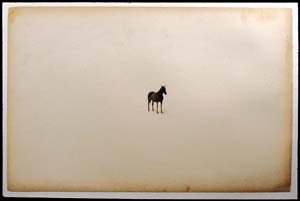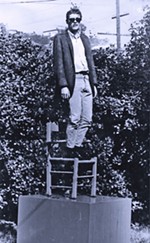Exhibitionism
Fri., Oct. 16, 1998
 HOUSE: TRANSCENDING THE RANT
HOUSE: TRANSCENDING THE RANT
Hyde Park Theatre, through October 17
Running Time: 1 hr, 5 min
"Hey, pal, listen up! This is the skinny on what's screwed up about the world..."
This is the Age of Rants. Our air is clouded with them: loud, agitated monologues bitterly denouncing the shattered state of our society and aggressively laying blame on all the cheats and degenerates and weak-willed dreamers responsible for this sorry situation. On TV, on talk radio, on the political stump, on the stand-up circuit, almost everyone is roaring out some sour soliloquy on Modern Life, and a noisy few are even making careers out of it: the Rush Limbaughs, the Eric Bogosians, the Dennises, Miller and Leary. All around us, the rant rules. So here comes a play in which a guy stands up and vents about his life, about what's all fucked up and who's to blame. So what? Why subject your poor battered ears to one more rant?
Because this one places you on a bus going north and starts you singing along to a song that you don't even know the words to.
Which is another way of saying that this is the rant of a poet, a rant of imagination and lyricism and depth that has the power to transport us through a troubled life in this troubled world to a place of feeling and mystery and light.
That power isn't immediately apparent. Early on, Victor, the disgruntled protagonist of this solo show, sounds strikingly like the standard Disenfranchised and Damn Mad About It White Maleô heard on just about every call-in show in the land. He has a lousy job, he's surrounded by losers, and no one appreciates him -- not his boss, not his folks, not his wife. Everywhere he looks, all he sees are people who are insensitive or selfish or just plain fucked-up, and he's sick of putting up with them.
However, the more Victor talks, the more you hear things that transcend the Stock Rant. For one thing, his jokes are better. He details the failings of those around him with a one-two punch of mockery and hyperbole that is outrageously entertaining. But even more distinctive are the bursts of surreal imagination that color his stories: His sister is having an affair with a huge dog named Hugo; his father ran away to join the circus and has a sideshow act in which he is the Saddest Man in the World; his mother sits catatonic before a TV set until Victor tells her that he wants to divorce his wife, then, as if possessed, her body rises to the ceiling and her tongue becomes an enormous whip with which she lashes her son. As we listen to him relate these events, it's clear that these aren't metaphoric embellishments on Victor's part; they are his reality. And so his rant takes on new colors, fantastic hues that shade this world, this life, in ways we were not expecting, and which make everything look different now.
Much of what distinguishes House is owed to the inventive script by Canadian playwright Daniel MacIvor. MacIvor has designed and constructed this work with the care of a master architect, giving it a solid foundation of character on which he builds a narrative of such striking personality and humor that you're drawn inside. And once across the threshold, you find he has laced it through with surprises, around every corner, in every room. The overwrought diatribes and family sagas -- each one more bizarre than the last -- are dense with imagery and language, unusual and provocative. These are not the ravings of some poorly focused malcontent getting something off his chest; they're stories by a man with something to say.
And in Frontera@Hyde Park Theatre's production, the stories are told in ways that make them personal and vivid and urgent. In part, that's because it's Ken Webster telling them; Webster has a knack for this kind of material, having ranted his way through Bogosian's Sex, Drugs, Rock & Roll to great acclaim and rants by guys like Mamet, Shepard, and their ilk. He's a great one for conveying fury -- lashing out in a deep, almost bestial bellow -- and anger rooted in the bottom chamber of the heart. He glares at us here, and his eyes blaze deep in the shadow of his brow like torches burning under the eaves of a house. And he knows how to tell a story, when to pause and when to goose a detail; his timing is a thing to behold. But as this is not just a rant, House calls on Webster to convey a broad range of feelings. And he responds feelingly, communicating Victor's frustration, his humiliation, his confusion, and his profound longing for a home. Not a house, a home.
And this is not a rant, but a play. In director Peck Phillips' work with Webster, refining his complex portrayal, in his use of simple yet startling stage effects (many of them rooted in Zach Murphy's lighting design), he provides a dynamism that defines this work as belonging in the theatre. With obvious care and artistry, this Frontera production takes us far beyond the rant, to a place of dreams, a place that might well be home. -- Robert Faires
LANCE LETSCHER: SUBLIME, QUIET BEAUTY
Gallery Lombardi, October 10
|
|
Wouldn't you know it? The day I arrived at Gallery Lombardi to review this collection was the day it was being dismounted. I walked in the door, and the artwork was coming down. Fortunately (for you as well as me), several of the pieces will remain on display indefinitely, and even a handful of these works comprise a worthy show, so great is their organic beauty.
The organic nature of these pieces comes both from their content and the media used to create them. Most of Letscher's works depict a single botanical image -- such as a stick or wasp's nest -- that he sketches on paper, cuts out with an X-acto knife, and pastes onto the background paper. He then runs the entire piece through a press, flattening it so that the 3-D effect is almost imperceptible. The relief is very subtle, as are the colors at play. He often uses coffee and tea as stains that he washes over the work, leaving irregular dark spots on an overall earthy-brown tone, a color similar to a milky cappuccino.
In Lilies, several spry, erect flowers are clustered together, their color almost identical to that of the background. But for the delicate shadows cast by the faint relief, and the few sketch marks within the flowers, it's easy to let the lilies blend into the background with a fleeting transience. The minor discrepancies in color, compounded by the barely there 3-D effect, leave the work with a sublime, quiet beauty, like a bunch of aging, dried roses.
Occasionally, Letscher uses a spot of gouachecolor starkly different from the rest of the earthy shades, such as in Toy Horse. Against a vast, grainy background stands the stirringly still image of a diminutive, opaque horse, alone in a seemingly barren and arid world. Tranquil and motionless, this tiny, proud horse perfectly epitomizes the composed and introspective beauty resonating throughout Letscher's works.
Letscher's relief technique may not be revolutionary, but his expertise at it, combined with his eye for design and comfort with negative spaces, gives his pieces a distinguished touch, one that is apparent in even just a handful of works. -- Cari Marshall
THE ARCHITECTURE OF SEEING: FROM NATIVE TO CLOWN
Dougherty Arts Center, October 2-4
It's the greatest show on Earth: a carnival of sideshow attractions, assembled outside the Dougherty Arts Center for the Dance Umbrella project The Architecture of Seeing. A drag queen version of Carmen Miranda floats by in a grocery cart decorated with leftover groovy flea-market trash, accompanied by his/her half-naked long-haired attendants, beckoning. Carmen wannabe groupies confront the audience, exploding the Carmen Miranda image-myth into its core issues: colonialism, racial stereotyping, slavery, and tourism. Booths and players drip with gaudy colors, plastic bananas, grass skirts, and bulky jewelry. We witness the birth of the Carmen stereotype, a multi-colored butterfly provocatively peeling herself out of a huge, zippered banana to tap dance energetically for our entertainment. A multi-personality diva quotes lines from movies -- "We don't need no stinkin' badges!" -- her fractured mood swings and endless repetition illustrating the frustration with Hispanic stereotypes. In another booth, a performer using a "Carmen" as a map of North and South America, suggests the perfect weight-loss plan: a slavery spa where you can get in shape working side-by-side with the natives. Perhaps the eeriest and most powerful tableaux features a feather-hooded, gargling tourist-clown switching identities with a native wearing a burlap sack. Watching the native put on the tourist's obnoxious mannerisms creates a shared sense of profound loss in the audience. Even the children, who wander over from the neighboring soccer field, stand transfixed and reflective. Then comes the obligatory rap number, undercutting the beatiful feeling of guilt, and we are herded inside.
The second half of the performance features visiting artists Patricia Hoffbauer and George Emilio Sanchez, who were commissioned by Dance Umbrella to create this project. Focusing their lens on issues of assimilation and cultural identity, the pair explore the transformation of the native into the clown, sex object, and,finally, into an assimilated ghost figure. Fragmentation touches every aspect of the performance, from the use of "Spanglish" to the use of filmed montages to the performers' gestures, which are repeated so quickly that they resemble Latin dance moves. Movement from the first half of the show reappears in the choreography as the performers struggle to create their own individual identities -- apart from the ones imposed on them by external, controlling influences. Clothing becomes a prison, trapping one in an unwanted identity. To shed the unwanted clothing is to celebrate the individual and to give hope to others caught in the search.
In all, the performance was an excellent blend of the serious and the humorous, dance and theatre, guest and local talent. The tone occasionally struck me as preachy and I felt battered by the message rather than moved by it. The most poignant moments were the quiet ones which tapped you on the shoulder rather than punched you in the face. Experiencing this show convinced me that you can tell someone about injustice over and over, you can rant and rave, jump up and down, and make a lot of noise, but sometimes a best message is best transmitted by a slow, clear whisper. -- Dawn Davis









